Jiuzhaigou Nature Reserve
Jiuzhaigou (九寨沟 Jiǔzhàigōu) is a nature reserve in the north of Sichuan province in south western China. It is officially known as Jiuzhai Valley in English. It is known as the habitat of giant pandas and for its many multi-level waterfalls and colorful lakes. It was declared a UNESCO World Heritage Site in 1992. It belongs to the category V (Protected Landscape) in the IUCN system of protected area categorization.
Understand
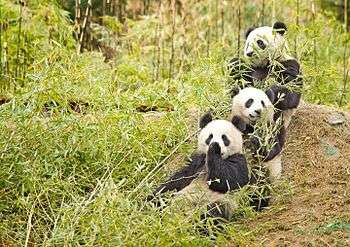
Jiuzhai Valley (Jiuzhaigou) is a major feature of the Sichuan Scenic Area, located 350 km north of Chengdu, the capital of Sichuan province. Jiuzhaigou is at the northeastern end of this scenic area in the Min Shan mountains. It is part of the Aba Tibetan and Qiang Autonomous Prefecture. The main scenic area stretches 80 km (50 mi) long in the form of a letter Y comprising of three main valleys - Shuzheng, Rize and Zechawa covering 720 km² (278 mi²) and offering stunning views of lakes, waterfalls, and mountains. The name means "Valley of Nine Villages", derived from the 9 ancient Tibetan villages that call it home. Its highest point is 4,700 m (15,420 ft) above sea level, with the main sightseeing areas between 1,980 m and 3,100 m (6,500-10,170 ft).
History
The remote region was inhabited by various Tibetan and Qiang peoples for centuries, but was not officially discovered by the government until 1972. Extensive logging took place until 1979, when the Chinese government banned such activities. The area was made into a national park in 1982. An Administration Bureau was established and the site was opened to tourism in 1984. Layout of facilities and regulations were completed in 1987. The site was inscribed by UNESCO as a World Heritage Site in 1992 and a World Biosphere Reserve in 1997.
In 2007, over 2.5 million people visited Jiuzhaigou. The site averages 7,000 visits per day, with a publicly reported cap of 12,000 (however this is never enforced). The desire to balance environmental protection and mass tourism has become an increasingly acute challenge for park management. Exploitation of natural resources for financial gain in the form of mass tourism is the utmost priority.
Landscape, geology and hydrology
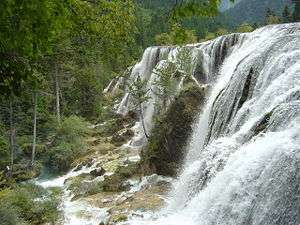
Jiuzhaigou's landscape is made up of high-altitude karsts shaped by glacial, hydrological and tectonic activity. It lies on major fault lines on the diverging belt between the Tibetan Plateau and the Yangtze Plate, and earthquakes have also shaped the landscape. The rock strata is mostly made up of carbonate rocks such dolomite and tufa, as well as some sandstone and shales.
The valley includes the catchment area of three gullies (which due to their large size are often called valleys themselves), and is one of the sources of the Jialing River, part of the Yangtze River system. The area covering 720 km² (278 mi²) of the Minshan mountains provides the catchment for the water system of Jiuzhaigou.
Jiuzhaigou's best-known feature is its dozens of blue, green and turquoise-colored lakes. Originating in glacial activity, they were dammed by rockfalls and other natural phenomena, then solidified by processes of carbonate deposition (travertine). Jiuzhaigou's water has a high concentration of calcium carbonate, making it so clear that the bottom is often visible even at high depths. The lakes vary in color and aspect according to their depths, residues, and surroundings.
Flora and fauna
The park is the natural habitat for two of China’s most treasured endangered species – the Giant Panda and the Sichuan Golden Snub-Nosed Monkey (金丝猴). However, due to the park's size and the number of tourists, the chances of seeing them are slim. About 20 pandas reportedly live within the boundaries of the park. There is probably higher chance of seeing them in Zaru Valley, the valley dedicated to eco-tourism. In the main valleys you are more likely to see other creatures including birds (140 species have been recorded here), insects and fish.
Despite all the lakes in the park, Jiuzhaigou is amazingly free of mosquitoes.
Nearly 300 km² (115 mi²) of the core scenic area is covered by virgin mixed forests. The flora changes greatly with altitude. In the lower regions of the valley, grasses and reeds abound. These are quickly replaced by bamboo forests which in turn give way to deciduous trees and conifers at the upper end of the valley. Beyond them the rocky slopes and snow-capped peaks of the Min Shan range dominate the view.
Climate
The scenic area of the park is at a height of between 2,000 and 3,000 m (6,562-9,843 ft). In summer the winds blow predominantly from the south and in the winter from the north. The summer months are most pleasant time to visit the park. Umbrellas and wet weather clothing as well as sun protection and hats are highly recommended as the weather at these altitudes can be fickle.
Jan Feb Mar Apr May Jun Jul Aug Sep Oct Nov Dec Average temperature (°C) 1.7° 4.4° 9.3° 14° 17.2° 19.7° 22° 21.8° 17.5° 13.2° 7.7° 3° Average precipitation (mm) 15 24 36 43 87 96 104 82 76 54 26 18
Get in
By road
The main departure points for a visit to Jiuzhaigou are Chengdu, Chongqing and Xi'an. Although Jiuzhaigou is only around 350km from Mianyang, and 460 km from Chengdu (as the crow flies), the journey takes between 8 and 11 hours due to the winding mountain roads through some spectacular scenery along the valleys of the Fu or Min rivers. Many tour companies break the journey into two components with overnight stops either at Mianyang or Maoxian.
Following the Sichuan earthquake of 12 May 2008, the road to Juizhaigou via Wenchuan and Maoxian is not recommended. The road between Chengdu and Wenchuan is excellent but Mao Xian - Chuan Zhu Si is undergoing landslide prevention and road widening works. The bus from Chengdu to Jiuzhaigou can take 7-11 hours.
If the area has experienced heavy rain, the mountain road to Jiuzhaigou may be closed. This can mean that there may be a delay as traffic backs up to wait for the road to reopen. In extreme cases, the road may not reopen at all, meaning that the bus and its passengers will have to spend the night in Dujiangyan, trying again in the morning. If you are travelling during these conditions, you may have to be very flexible with your itinerary.
From Mianyang an early morning start gets you to Jiuzhaigou township in time for dinner and the Tibetan cultural show (¥120-320). The route initially follows the deep valley of the Fu river then over Longmen shan (Dragon gate mountain) to Qingchuan and Wenxian before reaching Jiuzhaigou County Town nestled in the valley of the Baishui river. The mountain and river views make even the journey a worth while tourist experience.
Public Bus services are available from the Xinnanmen and Chadianzi bus stations in Chengdu to Jiuzhaigou, with 2 or 3 departures from each station daily depending on demand. Ticket price is approximately ¥110-145.
There are daily buses to the park from Songpan, and Huanglongsi National Park.
Taxi: If there are a few people, it may make sense to charter a taxi to/from where you're going. Fares of ¥600-700 to Langmusi have been reported. It is also reportedly possible to take a taxi to/from Chengdu for around ¥1200, which is probably cheaper than flying for 3 people and much more comfortable than a bus.
By plane
Flights between Chengdu and Jiuzhaigou Huanglong airport (JZH IATA) are available on Air China, Sichuan Airlines, Hainan Airlines, South China Airways and China Eastern. As of July 2013 direct flights are also available from Beijing, Chongqing, Shanghai, Xi'an and Hangzhou on various airlines. Jiuhuang airport is about a 1.5-hour drive from the park entrance. This can be done by taxi or mini-bus. Taxis charge a fixed rate of ¥260 during the day, and ¥360 at night. The airport shuttle bus costs ¥50 per person, with a counter right after the baggage reclaim, but stops running around 18:00. Min. number of passengers for the bus is 10, but if there are at least 4 passengers turning up at the same time, they might pool all of them into a single taxi for the price of the shuttle bus.
Most visitors access Juizhaigou by road.
Fees and permits
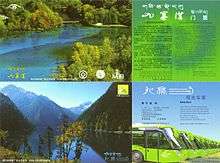
The Jiuzhaigou Administration centre contains the Ticket Office. Tickets are sold from 06:30 until 19:00 daily. The price during peak season is ¥220, there is a separate non-mandatory an insurance fee of ¥10. Disabled visitors, Seniors between 60 and 70 years of age, students and soldiers get a discount price of ¥110 (as of July 2013). Children no taller than 1.3 m in height, government servants and seniors over 70 get in free.
A one day bus ticket costs ¥90. Bus tickets are not mandatory. Many people choose to buy one as it is over 30 km from the entrance to the top of the park. There is a sign inside the park saying that if you then decide you want to buy a bus ticket inside you have to pay ¥140.
It takes around three hours to walk from the park entrance to Nurilong waterfalls if you are fit and healthy. Two days in the park, one day on the bus to see the upper parts and one to walk to the lower parts is a good compromise if you have the time.
Tickets are only valid for one day. Two-day tickets are available only during the off-peak season. Make sure if you get a two-day pass that you go to the room next to the ticket booth and have your picture taken and printed on your ticket. If you don't you won't be able to reenter the park on the second day.
In the dry season (February) many of the wooden trails in the park are closed and marked as fire hazards. It is possible to walk on the roads in the park although there are some signs saying this also isn't allowed. The only other option is to bus around the park.
Off peak ticket prices:
- Entry – ¥80
- Student / OAP Entry – ¥70
- One Day Bus ticket: – ¥80
- Winter 2nd day entry ticket – ¥20 (must be purchased at the same time as the first day's ticket)
Get around
There are plenty of taxis in Jiuzhaigou. There are also mini-buses (they really are minivans) to the most popular tourist destinations in the Jiuzhaigou region. Car rentals are also available and range from ¥500-900 per day.
Perhaps the easiest way to get around without a tour guide is using one of the "self service travel websites" that are really popular with young Chinese tourists who are not looking to travel with a tour group. Unfortunately for people who cannot search the web using Chinese characters (pinyin does not work very well) these sites are near impossible to find. On these sites you can buy tickets to local cultural events, arrange for pick up service, rent cars, arrange for tour guides, and finding Tibetan local host families for a cultural experience. However, they are extremely hard to find with names that are usually just strings of letters and numbers like cq966.com. The mentioned website is actually ran by locals attached to Chang Qing (长青)hotel - one of the two hotels (other is the Sheraton) with the most credibility among tour guides within Jiuzhaigou proper. You can email these websites in English or contact them through MSN and they will be able to respond. Most local hotels are also good sources for advice on how to get around Jiuzhaigou but only a few speak languages other than Tibetan and Chinese
Inside the park
For environmental protection reasons, no personal transport, not even bicycles, are permitted within the park. However, with a bus pass you can take a bus to all of the sites within the park. Your pass gives you access to an efficient hop-on hop-off bus transport system. Every few minutes a bus will come to a site to pick up passengers. The buses are frequent and sometimes crowded during the peak season, running from early morning until the park closes. Don’t miss the last bus or you must walk out! When entering the park you will be herded effectively and politely into one of the many queues waiting for transport. Once in the system you are a free to move within the park and see whatever you want. An effective way to use the system is to take the bus to the head of Rize valley and walk back towards the entrance and Administration building. Walking is a great option in the park, as wooden-plank trails wind through the lakes and forests. It is best to combine walking with taking the bus as the park is quite large and you won't be able to cover enough ground on foot. The park officials herd people out from the upper parts of the park well before the official closure time (from about 16:30).
Around the local area
Public buses run from the centre of the town to Chengdu, Huanglong, Chadianzi, Jiangyou and Songpan. For up-to-date bus schedules and travel options from Jiuzhaigou the best place to check is the Jiuzhaigou official website
From Chengdu the public bus costs between ¥110-145 and takes around 10-13 hours.
See and do
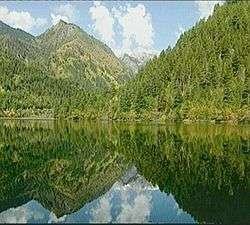
Jiuzhaigou is all about seeing! The colours of its lakes, trees and mountains are breathtaking and defy adequate description. The altitude changes within the valley to create continual variations of flora, which give each lake and waterfall a unique quality.
Although Jiuzhaigou is a great place to visit at any time of the year Spring and autumn are best. Winter provides many magnificent sights with frozen lakes and waterfalls, but the day temperatures are very low and accessibility by road is neither easy nor guarantee-able. Summers can be slightly crowded with beautiful sunshine in the early parts and it often rains in July and August. The fresh air and lack of humidity make it a great break from the city. Autumn is, in many opinions, the pick of the seasons. From late September through October to early November the colour contrasts of red and gold leaves set against the greys of the Bamboo forest and the dark greens of the conifers provide the perfect backdrop to the blue, cyan and vivid greens lakes.
Jiuzhaigou has some 114 Lakes and waterfalls. Here are a selection of scenic locations to visit:
- Long Lake is at the head of the Zechawa valley. At an altitude of 3,060 m (10,039 ft) this is the biggest and deepest lake in Jiuzhaigou. The lake has a surface area of approximately 30 km² (12 mi) and an average depth of 44 m (144 ft). On clear days its dark wooded hillsides and blue waters are viewed against the backdrop of the 5,000 m (16,404 ft) snow capped Min Shan mountains. This lake has no major inflow and receives its water from underground sources. The local Tibetans have their own name for this lake, which translates, to “The Lake that never dries out.” Take the bus to the Long Lake and Jade Colored Pool because it is too far to walk to.
- Five Colour Pool also known as the Jade pool, is a small lake of 5,600 m² (60,000 sq ft) at an altitude of 2,995 m (9,826 ft) and with an average depth of 6.6 m (21.5 ft). It is fed by underground streams from Long lake. Although small this lake must be rated as having one of the most varied and intense colour ranges of Jiuzhaigou and should not be missed. The lake systems in the lower parts of Zechawa valley are seasonal and are often dry in summer. Walkways are provided from Long Lake to a bus pickup point just passed the lower seasonal lake.
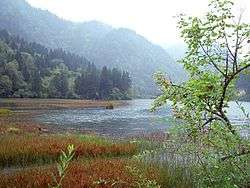
- Grass Lake at 2,910 m (9,547 ft) is the highest lake in the Rize Valley. The valley here is narrow and steep. The lake was formed as a result of an ancient mudflow about 10,000 years ago and travertine sedimentation. The lake is shallow with large evergreen grassy beds.
- At an elevation of 2,905 m (9,530 ft) Swan Lake is surrounded by high rocky cliffs that drop vertically into the lake. The lake takes is name from large numbers of migratory swans that visit it each year.
- Arrow Bamboo Lake is the first of the deep lakes. Set at an altitude of 2,680 m (8,793 ft) and 6 m (20 ft) deep it has a surface area of 170,000 m² (1,830,000 sq ft). An unusual characteristic of this lake is that it never freezes even when the Panda Lake 100 m (328 ft) lower is completely covered in snow and ice. The lake is surrounded by Bamboo groves and together with the Panda Lake.
- Panda Lake has an average depth of 14 m (46 ft) and as its name implies is in the heart of panda country. This 90,000 m² (969,000 sq ft) lake at 2,590 m (8,500 ft) altitude is surrounded by bamboo forests and a mix of deciduous and coniferous woodland. This vivid green lake becomes a feast of colour in the autumn. The lake is home to many small and curious Songpan Naked Carp that gather in large numbers when a leaf or pebble falls into the lake. The fish are protected and must not be fed by visitors.
- Water exits Panda Lake via the spectacular Panda Falls. These narrow falls have a drop height of 120 m (393 ft) and cascade down to the “Five Flower Lake” over a series of travertine terraces. A well-maintained wooden walkway allows visitors to descend beside the falls providing a unique way of seeing the spectacle.
- Five Flower Lake at 2,472 m (8,110 ft) and just 5 m (54 ft) deep is referred to as the soul of Jiuzhaigou. Its shallow cyan coloured waters provide the visitor with an outstanding display of is bottom sediments containing trees, bushes, and leaves in great array. Its waters drain via the peacock riverbed, claimed locally to be the shortest and most beautiful river in the world, to one of Jiuzhaigou’s most appealing waterfalls. The “Pearl Shoal Falls”
- Pearl Shoal and Pearl Shoal Falls are best viewed by taking the walkway. This takes visitors across the “Golden Bell Lake” and “Pearl Shoal” down the left side of the falls then across the base of the Falls to “Mirror Lake”. The shallow waters rush over the 160-m (525 ft) wide travertine shelf called” Pearl Shoal” creating a noisy bubbling cascade which from a distance looks like a shawl of pearls draped across the hillside. The falls have a drop height of 21 m (69 ft) and are 162 m (532 ft) wide providing a spectacular display.
- Mirror Lake is so named because of its ability to reflect the images of the surrounding mountains and forests. The lake at an altitude of 2,410 m (7,907 ft) is in a sheltered section of the valley running east west which produces its glassy reflective surface.The Lake was featured in the Zhang Yimou movie Hero. The outflow of “Mirror Lake” is through the “Rize Gully” a travertine ramp of small ponds and natural bonsai trees and bushes that lead directly to one of the great sights of Jiuzhaigou . The Nuorilang waterfall.
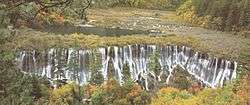
- The Nuorilang Falls are situated, at an altitude of 2,365 m (7,760 ft), at the junction of the Zechawa, Rize and Shuzheng valleys. Best viewed from the Shuzheng valley road the 250-m (820 ft) wide veil of water flows out of the thick shrubs and bushes of Rize Gully to drop 24 m (79 ft) into a small ravine below the road.
- Rhinoceros Lake at 2,315 m (7,696 ft) and with a surface area of some 200,000 m² (2,153,000 sq ft) is the largest lake in the Shuzheng valley, and also the deepest with an average depth of 12 m (39 ft). The lake derives its name from a legend that tells of a monk from Tibet riding a rhinoceros. When the monk came to this lake he was so entranced with the local scenery that he accidentally rode his rhinoceros directly into the lake.
- Shuzheng Village bedecked with prayer flags, is one of the nine Tibetan villages that give Jiuzhaigou its name. Situated above the Shuzheng Lakes it is easily accessed from the roadway. Here you can visit a traditional Tibetan home and drink “Yak Butter tea“. The steep main street is lined with shops selling trinkets, Tibetan artifacts and souvenirs.

- Shuzheng Lakes and waterfalls are at 2,215 m (7,268 ft) the lowest series of lakes in Jiuzhaigou; Spread across the valley this series of small lakes and waterfalls cascade down the lower valley and drain directly into Baishui Jiang.
The last three features are the Sleeping Dragon Lake, Reed Lake and Bonsai beach. Sleeping Dragon Lake contains a large travertine shelf that extends across the floor of the lake. Locals say it looks like a sleeping dragon and that the head and tail seem to move as the wind ripples the lake surface.
To make the most out of your one day in the valley, buy the ticket at 07:00 and take the bus up the right fork to Primeval Forest. Walk the trail around the forest then walk the forest path down to Swan Lake. It is advisable then to bus down to Arrow Bamboo Lake and then walk all the way down to Nuorilang. Have your lunch and bus up the left fork to Long Lake and walk down to Five Colour Pool. Subsequently, bus down to Nuorilang and walk till the Bonsai beach before taking the bus to the entrance.
Buy
There are lots of Tibetan trinkets that could entice the younger ladies. There is a shop next to the entrance which sells a good collection of postcards and reading materials about the park itself.
Eat
Being a UNESCO World Heritage Park in China does not mean it is fully decked out for non-Chinese visitors. There is a centrally located, sort of a HQ area with a restaurant serving buffet lunch. Typically Chinese stir-fry dishes. At the entrance, there is a Chinese fast food outlet serving fried chicken, and vendors selling ramen and other types of instant noodles.
A one-day stock of muesli bars and a flask of tea or coffee would help, especially if you plan to take in all the heavenly sights on foot, through the wooden planked pathways. In autumn and spring, the temperature is suitable for resting along the wooden plank path while having a nice warm drink while you wait for the lighting to be just right for your next photo shoot.
- The food and drink in the Reserve is very expensive (dish of rice about ¥30, noodles ¥15, small bottle of water ¥5) so it's a good idea to obtain supplies in the shops outside before you enter.
Drink
There are many areas to drink. You will find one of the best local Tibetan tradition is to drink Tibetan butter tea. There is a surprising amount of bars available on bian bian jie (边边街) which is one of the most famous cobblestone roads in China.
- 6868 bar (Just past the Sheraton off main road in the small town there). Any cab driver should know this place. Typical Chinese-style club, with a dance floor, private rooms, and lots of tables with drinking games. If you want to drink with the locals, worth checking this place out... remarkably good light system and sound system for the rural area.
Sleep
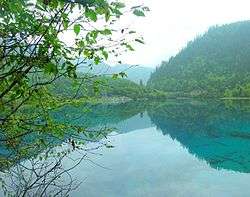
Despite whatever they tell you, lodging in the park is illegal.
Lodging
There are no hotels or commercial accommodation within the park. It used to be possible to stay at the home of a local villager for a small fee. The authorities however do not approve of the practice and as such it is not recommended.
There are now a number of 5-star, 4-star and 3-star hotels and cheap hostels just outside the park.
The price for a 5-star hotel such as the Jiuzhaigou Xilaideng International (Sheraton) is from ¥600-1,000.
For 4-star hotels like Chang Qing binguan (长青宾馆), the Geshang hotel, the Chinese Travel hotel, and the Golden Harbour Hotel room prices are from ¥400-900.
A 3-star hotel such as the Xing Long binguan(鑫隆宾馆), Qianhe Hotel, is from ¥300-800.
A lot of the hotels have different level "rooms" within the hotel which are priced accordingly. Thus you see a great deal of price ranges within the same hotel.
Prices vary according to the season and booking in advance is essential.
There is one authentic homestay (others are "Tibetan themed" often outside owned) run by a local family a 15 mins drive from the park entrance. They do not have a website but they can be contacted at . There are also two hostels in the immediate area.
There are a number of cheap hostels to the West of the park entrance. You should be able to get dorm rooms for around ¥35 and double bedrooms for ¥100.
Angelie Hotel in Peng Fend Village, about 15 minutes from the park entrance is recommended (Wi-Fi, hot water, nice English-speaking staff, tours, car sharing).
Uncle Jiang's family house, Peng Feng Village, Jiuzhaigou Park Entrance. They have free pick-up and offer packed lunches (sandwiches) for ¥20.
Using the local travel websites will allow you to purchase price for cheaper, kind of how the aggregate websites will allow you to get a room for cheaper. However, they are pretty hard to find unless you search with Chinese characters.
There is lodging located in the villages along the street outside the park entrance. For budget travelers the best option is the Jiutong Bingguan (九通兵官) located next to the bus station. Touts crowd around arriving buses and can lead you to alternative budget options.
Camping
Hiking and camping are available within the Zaru Valley of the national park. Zaru Valley has an amazing 40% of all the plant species in the whole of China and if you are to see any of the wildlife of the national park, this represents the best chance. The main hike is a 3-day hike, following the pilgrimage of the local Bebbo Tibetan Buddhists around the 4,500 m+ (14,764 ft+) Zhayizha Ga Mountain.
Stay safe
The highest tourist destinations reach heights above 3,100 m (10,170 ft) and altitude sickness is a possibility.
In the winter months the park is extremely cold and it is necessary to dress warmly. Having said that, in the winter sunshine you could possibly strip down to a t-shirt in the bright winter sun shine - in the shade you'll need to layer up again however!
Chinese tourists dread standing in line and there is a lot of pushing and shoving getting on and off buses. Make sure you don't get pushed in front of an oncoming bus. Crowded trails can also be dangerous and if you walk on the edge of a path it is likely a shoulder or elbow with push you off. To really enjoy your time in the park you should walk on the trails on the opposite side of the lakes from the roads. These trails have considerable less tourists and you can really experience the serenity of the national park there.
English is not widely spoken in Jiuzhaigou.
Go next
Every day buses go to Songpan at 07:20 and take two hours, Chengdu (10 hours) and Huanglong National Park. Bus times vary from time to time. It is best to keep an eye on the Jiuzhaigou website for up-to-date times.